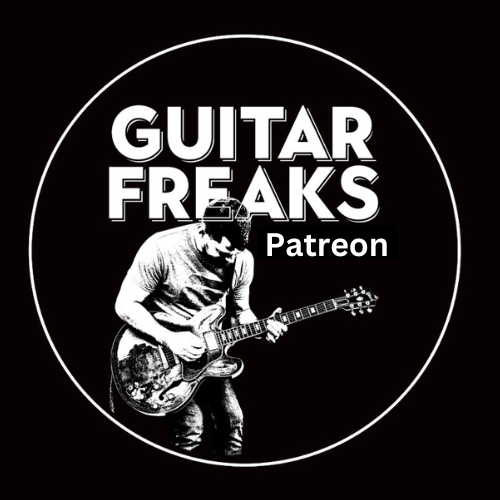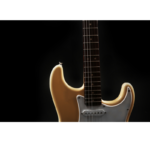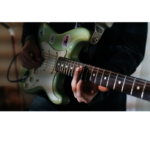How to Improve Rhythm Guitar: Build the Backbone of the Song
Rhythm guitar is the engine room—the groove that lets everything else breathe. When your rhythm is solid, you drive the band, support the lead, and set the mood for the audience. Mastering rhythm isn’t just “strumming better”; it’s phrasing, time, harmony, and touch. This guide gives you creative ways to strengthen your rhythm playing with clear techniques, focused practice, and progression ideas you can use today.
Why Rhythm Guitar Matters
Lead lines turn heads, but rhythm keeps heads nodding. Great rhythm players:
- lock with the drummer and bassist,
- shape the harmony and feel of each section,
- create momentum with dynamics, space, and accents.
If you can craft tight, musical patterns that support the song—and know when not to play—you become everyone’s favorite guitarist to work with.

🎸 Join the Guitar Freaks Patreon!
Get SoloCraft E-Book FREE!
When you join Guitar Freaks on Patreon, you’ll instantly unlock my full e-book SoloCraft—your complete guide to fretboard mastery and building unforgettable solos. Think of it as your shortcut to playing with confidence and creativity.
👉 Don’t miss out—join now and grab your free copy!
Essential Techniques for Rhythm Guitar
1) Syncopation & Groove
What it is: Accenting the “ands” (off-beats) to create forward motion. It’s central to funk, reggae, R&B, indie, and rock.
Try this
- Set a metronome to 70–80 BPM.
- Strum a simple G–C–D progression.
- Accent only the upstrokes on the “and” of each beat for eight bars.
- Now alternate: two bars straight 8ths → two bars syncopated. Notice how the pocket changes.
Goal: Keep the groove steady while your accents move.
2) Palm Muting for Percussive Control
What it is: Lightly resting the picking-hand palm near the bridge to shorten sustain and add punch—perfect for rock and tight pop rhythms.
Try this
- Chug low-string power chords in steady 8ths for four bars.
- Open the mute (let chords ring) on beats 2 and 4 only for the next four bars.
- Alternate “chug and bloom” for a full chorus.
Goal: Use muting as a dynamic fader, not just an on/off switch.
3) Chord Embellishments & Ghost Notes
What it is: Small moves—hammer-ons, pull-offs, slides, sus2/sus4—plus quiet “ghost” strums that keep time between accents.
Try this
- Over C–G–D, add a quick hammer-on inside each shape (e.g., open → 2nd fret on a middle string).
- Keep your strumming hand moving in 8ths; let some strokes be ghosts (barely touching strings).
- Aim for “drum set” energy with your right hand while the left hand paints color.
Goal: Make simple chords feel alive without clutter.
Creative Rhythm Progressions
1) Passing Chords for Motion
What it is: Transitional chords that connect two main chords and add tension/release.
Ideas to try
- Chromatic dim7: In G–C–D, sneak D#°7 between C and D.
- Slash bass: G → G/B → C for smoother movement.
- Backcycling: Add a quick Am7–D7 before G (a ii–V into the I).
Goal: Create small harmonic “steps” that lead the ear.
2) Time Signatures & Accents
What it is: Shifting the metric feel to refresh a progression.
Try this
- Take Em–G–D from 4/4 into 3/4 (count “1-2-3”).
- In 4/4, try a hemiola: accent every three 8th notes for two bars, then snap back to the backbeat.
Goal: Keep the band grounded while adding interest with placement.
3) Extended Chords & Shell Voicings
What it is: 7ths, 9ths, 13ths for richer harmony; or lean “shells” (3rd + 7th) for clarity.
Try this
- Swap C → Cmaj7, G → G13, D → D9 in a verse.
- Practice 3–7 shells on the middle strings and slide them through a progression for tight voice-leading.
Goal: Upgrade color without sacrificing groove.
Developing Rhythmic Phrasing
Call-and-Response
Create a two-bar “question” with a syncopated pattern, then a two-bar “answer” that’s more open or uses rests. Record a loop and trade phrases with yourself.
Accent Shifts
Play G–C–D for eight bars. First pass, accent beats 2 and 4. Second pass, accent the “and” of 2 and the “and” of 4. Same chords, new feel.
Subdivision Control
Cycle for two bars each: quarters → 8ths → triplets → 16ths, keeping the volume and tempo even. This trains your internal clock.
A 12-Minute Daily Rhythm Plan
- Warmup (2 min): Metronome on, mute the strings, strum steady 8ths.
- Groove (3 min): Syncopation drill on one progression.
- Texture (3 min): Palm-muted verse into open-ringing chorus.
- Harmony (2 min): Add one passing chord or shell voicing to a familiar song.
- Phrase (2 min): Call-and-response over a loop, leaving space in the “answer.”
Do this four days in a row. On day five, record a one-minute take—you’ll hear cleaner time and more confident feel.
Electric-First Tone Tips (for Rhythm)
- Pick attack > gain: Start clean or edge-of-breakup; let the right hand create punch.
- Pickup choice: Neck or middle for chord clarity; bridge for tight, percussive parts.
- EQ & compression: Roll a touch of treble if strums are spiky; light compression can even out accents.
- Effects tastefully: Short room reverb and minimal delay keep transients sharp.
Join the Guitar Freaks Patreon

🎸 Join the Guitar Freaks Patreon!
Get SoloCraft E-Book FREE!
When you join Guitar Freaks on Patreon, you’ll instantly unlock my full e-book SoloCraft—your complete guide to fretboard mastery and building unforgettable solos. Think of it as your shortcut to playing with confidence and creativity.
👉 Don’t miss out—join now and grab your free copy!
Wrap-Up
Improving rhythm guitar is about control and creativity: steady time, smart accents, tasteful harmony, and dynamic touch. Work the drills above, experiment with passing chords and extended voicings, and shape phrases like a conversation. Keep recording yourself, listen back, and iterate.
Pick up the guitar, set a click, and start strengthening the backbone of your songs—one clean, confident strum at a time.










